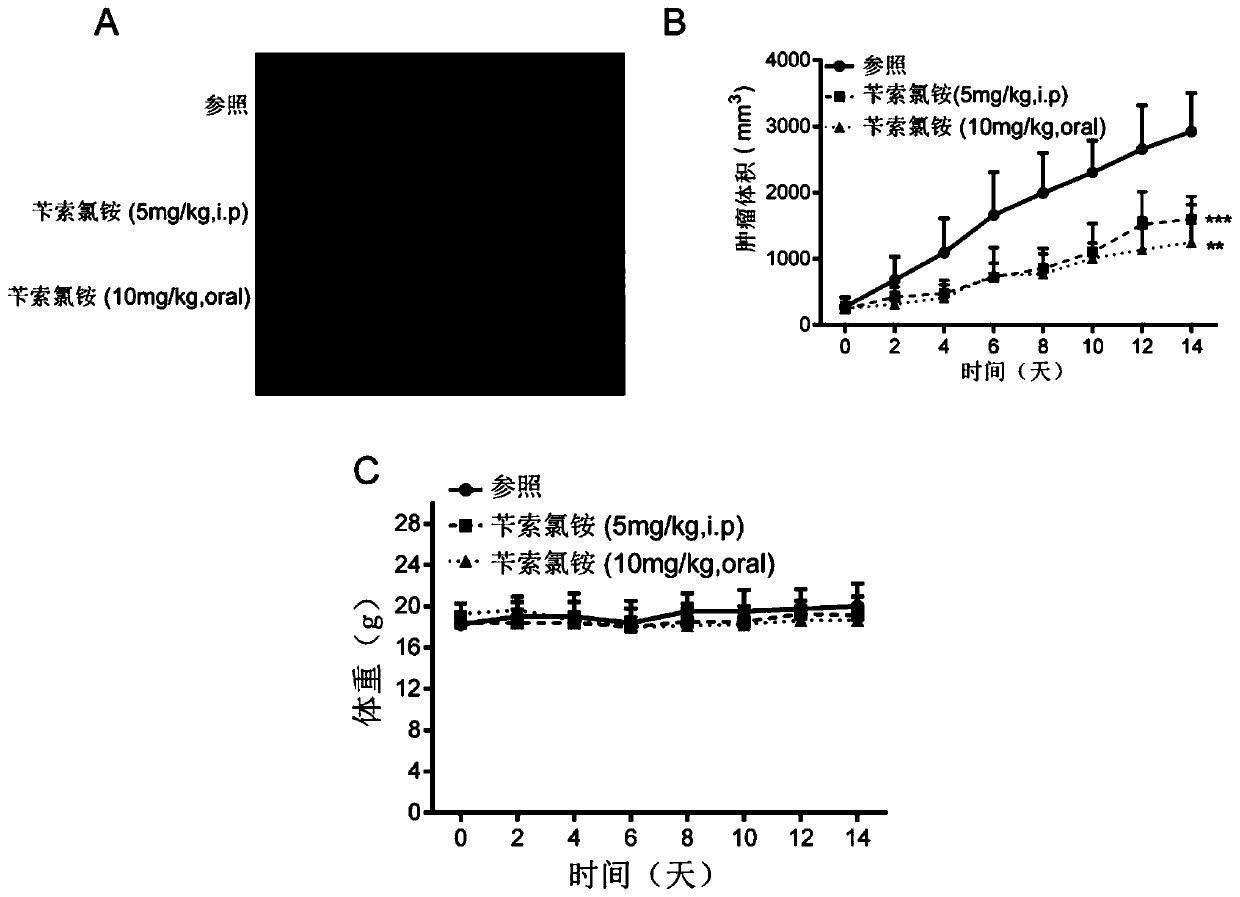Application of benzethonium chloride in preparation of drugs to prevent and treat lung cancer
A technology of benzethonium chloride and medicine, which is applied in the field of medicine, can solve the problems of inhibiting the growth of lung cancer cells, and achieve the effects of small toxic and side effects, high safety and low price
- Summary
- Abstract
- Description
- Claims
- Application Information
AI Technical Summary
Problems solved by technology
Method used
Image
Examples
Embodiment 1W
[0028] Example 1 WST-1 cell activity detection
[0029] 1. Cell plating: A549 and H1299 cells (purchased from the American Type Culture Collection (ATCC) cell bank) were collected, counted, plated in a 96-well plate at an amount of 3000 cells per well, and cultured overnight.
[0030] 2. Drug treatment: Dilute benzethonium chloride with DMEM complete medium to the treatment concentration (0, 5, 10, 15, 20 μM), then replace the original medium in the 96-well plate, and treat for 24, 48 and 72 hours respectively.
[0031] 3. WST-1 detection: according to the dilution ratio of 1:10 (w / v), dilute WST-1 (WST-1 cell proliferation detection kit) with DMEM complete medium to obtain the medium containing WST-1; then The medium containing WST-1 was used to replace the original medium in the 96-well plate, and the medium containing WST-1 was added to wells without cultured cells as a blank control, 100 μL per well. Then put the 96-well plate in a constant temperature incubator at 37°C a...
Embodiment 2
[0033] Example 2 Apoptosis
[0034] 1. Drug treatment: A549 and H1299 cells were collected and spread in 6-well plates, so that the cell density was about 40%, and DMEM medium containing 0, 10, 15 and 20 μM benzethonium chloride was added to treat the cells.
[0035] 2. Collect cells: After 48 hours of drug treatment, first collect the apoptotic cells in the supernatant, centrifuge at 1100rpm for 3 minutes, discard the supernatant, then digest the adherent cells with 0.25% trypsin, and collect them in the same centrifuge tube. After centrifugation at 1100rpm for 3min, the supernatant was discarded. Staining was performed after washing twice with PBS buffer.
[0036] 3. Staining: First resuspend the cells with 500 μL of Binding Buffer (Apoptosis Detection Kit), then add 5 μL of Annexin V-FITC to each tube and mix well, then add 5 μL of Propidium Iodide and mix well, then react for 15 minutes at room temperature in the dark .
[0037] 4. Flow cytometry: After staining, use a ...
Embodiment 3
[0039] Embodiment 3 subcutaneous tumor formation experiment in nude mice
[0040] 1. The animal experiments in this project strictly complied with the guidelines of animal care institutions, and all were approved by the Animal Experiment Ethics Committee of Jinan University.
[0041] 2. The experimental animals used in this project are 6-8 weeks old female nude mice (Balb / c-nu, purchased from the Experimental Animal Center of Southern Medical University), a total of 15, including 5 in the control group and 10 in the experimental group, Construct subcutaneous tumor formation model in nude mice:
[0042] (1) Cell collection: collect cells for cell counting, and use 1×10 cells per nude mouse 6 The total number of cells was calculated based on the amount of A549 cells, and the cells were resuspended in PBS buffer and mixed with Matrigel (purchased from Guangzhou Sier Biotechnology Co., Ltd., coring) at a volume ratio of 1:1.
[0043] (2) Inoculation: after the mice were anesthet...
PUM
 Login to View More
Login to View More Abstract
Description
Claims
Application Information
 Login to View More
Login to View More - R&D
- Intellectual Property
- Life Sciences
- Materials
- Tech Scout
- Unparalleled Data Quality
- Higher Quality Content
- 60% Fewer Hallucinations
Browse by: Latest US Patents, China's latest patents, Technical Efficacy Thesaurus, Application Domain, Technology Topic, Popular Technical Reports.
© 2025 PatSnap. All rights reserved.Legal|Privacy policy|Modern Slavery Act Transparency Statement|Sitemap|About US| Contact US: help@patsnap.com



